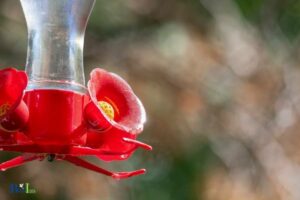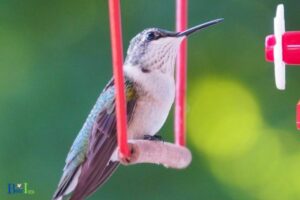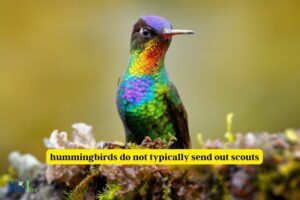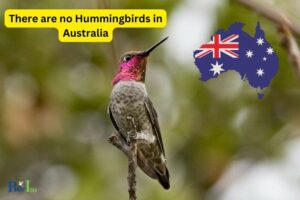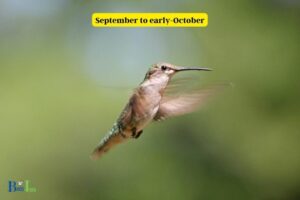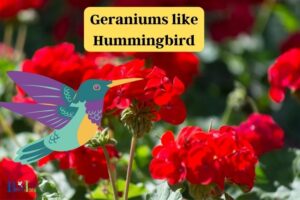Why Wont Hummingbirds Come to My Feeder: Reasons!
Hummingbirds won’t come to a feeder for several reasons, such as the location of the feeder, if the feeder is covered or not, and the type of feeder used.
Hummingbirds are attracted to feeders that mimic the nectar of their favorite flowers.
If your feeder is filled with the wrong type of food, such as artificial red dye or honey, it could deter hummingbirds.
Additionally, the location of your feeder is crucial. If it’s not in a safe, quiet, and shady spot, hummingbirds may bypass it.
A dirty feeder can also be a deterrent as it can harbor mold or bacteria that are harmful to hummingbirds. Finally, too much human movement and noise around the feeder can scare hummingbirds away.
Overall, hummingbirds won’t come to a feeder if it isn’t placed in the right location, has a cover over it, or is not the right type of feeder.
Additionally, it must be cleaned regularly to make sure the nectar is fresh and uncontaminated.
8 Reasons Why Hummingbirds May Not Be Coming to Your Feeder
| Reasons | Description |
| Wrong Type of Feeder | Hummingbirds may prefer feeders that are designed to mimic the shape and color of flowers, which is what they are naturally attracted to in the wild. |
| Feeder Location | If the feeder is not placed in a location where hummingbirds can easily see it or if it’s in a high traffic area, hummingbirds may not use it. |
| Empty or Dirty Feeders | Hummingbirds will not come to a feeder if it is empty or if it is dirty. Clean feeders with warm water and mild soap regularly. |
| Wrong Food | The food that you are using in your feeder may not be attractive to hummingbirds. They are most attracted to nectar that is made from white sugar and water. |
| Presence of Predators | If there are predators like cats or large birds near the feeder, hummingbirds will stay away. |
| Lack of Other Attractors | In addition to feeders, hummingbirds are attracted to gardens that include a variety of flowering plants in different colors, particularly red. |
| Migration | If it’s not hummingbird season, these birds may have migrated to a different region. |
| Competition | If there are too many birds and not enough feeders, some hummingbirds may choose to find an alternative food source. |
Key Takeaway
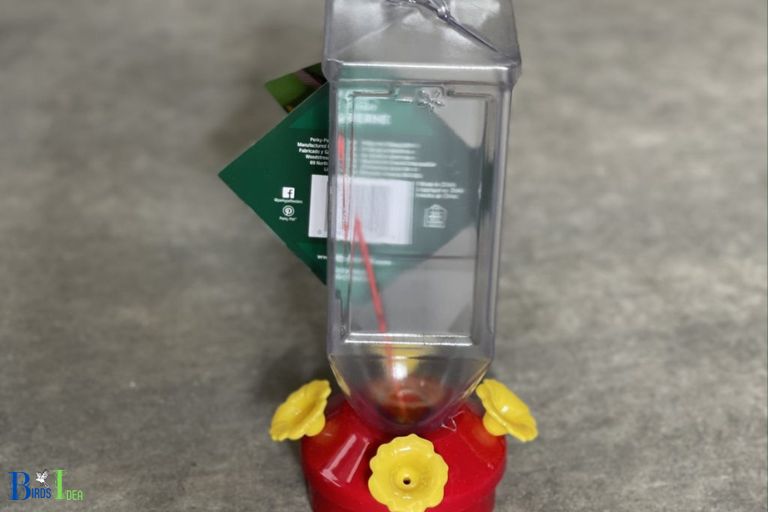
Five Facts About: Hummingbirds May Not Be Coming to Your Feeder
DID YOU KNOW
More than 330 different hummingbird species currently exist with the smallest species being just 2 inches in length.
Why Don’t Hummingbirds Come To Feeders?
Hummingbirds are beautiful, captivating birds and many people enjoy watching their graceful, hovering flight patterns as they feed from nectar flower blooms.
For this reason, many people are surprised when hummingbirds do not come to their feeders like other backyard birds.

There are a few reasons why hummingbirds may not visit your feeder:
Location: Hummingbirds are migratory birds and may not be present in your area during all seasons. In addition, different species of hummingbirds may frequent different areas.
Food Preferences: Hummingbirds can detect the carbohydrate content of nectar, so it is important to use a feeder containing the right mixture of sugar and water.
Predators: Hummingbirds are prey to several larger birds and animals, so they may avoid feeders in open areas.
Competition: Hummingbirds tend to prefer feeding on flowers as opposed to feeders, so they may choose to feed on blooms to avoid competition with other birds.
Hummingbirds are unique birds that require specific conditions to stay in an area. To increase your chances of attracting hummingbirds to your feeder, it is important to understand their behavior and preferences.
Consider moving your feeder to a shadier spot and fill the feeder with a mixture of four parts water to one part sugar. This can help attract hummingbirds to your feeder.
Summary of Reasons
A summary of reasons can be a useful tool to help quickly identify the primary ideas and arguments of a particular topic.
Reasons can be used to support an opinion or action, or to explain why something is the way it is.

Below is a list of reasons why a summary of reasons can be a helpful tool:
- Saves time: Summarizing the main points of a topic quickly and efficiently allows for more time to spend on other important tasks.
- Keeps focus: By pinpointing the most relevant points, a summary of reasons can keep one on track and help ensure that important ideas are not forgotten.
- Clarity: A summary of reasons provides a clear and concise overview of the main ideas, helping to make complex topics more understandable.
For example, let’s say a student is studying the effects of climate change on the environment.
A summary of reasons can provide a quick overview, such as the fact that climate change is caused by human activities, that it is contributing to rising temperatures, and that the resulting environmental changes are leading to a decrease in certain species of animal and plant life.
A hummingbird’s accomplishments surpass the load of an elephant.”
birdsidea
Placing a Feeder Near Blooms
Location is an important factor when placing a bird feeding station in your yard. When deciding where to place your feeders, it is important to consider the needs of the birds.
Placing a feeder near blooms can provide birds with a consistent source of food that they can rely on.

Benefits of Placing a Feeder Near Blooms:
- Blooms provide shelter and protection from predators.
- Birds can find food more easily in an area with blooms.
- Blooms attract a variety of insects, which in turn attract birds.
- Placing a feeder near blooms can provide a consistent, steady food source for birds.
For example, if you have a flowering shrub in your yard, placing a feeder near the shrub can attract a variety of birds.
The feeder can provide a steady source of food while the blooms provide shelter and protection. Alternatively, if you have a garden or flowerbed, you can place a feeder near the blooms to attract birds.
By placing a feeder near blooms, you can provide birds with a consistent, steady source of food. This can help keep birds healthy and provide them with the nutrition they need to survive.
Moreover, placing a feeder near blooms can also attract more birds to your yard, providing you with a beautiful and lively display of nature.
Uncovering the Feeder
A Feeder is a type of electrical wiring system that is used to provide electricity from a main power source to different kinds of smaller electrical loads.
Feeders are commonly used in residential, industrial, and commercial settings, as they help to reduce the cost of energy consumption.

The main components of a Feeder system are the main power source, the feeder line, and the feeder breaker.
The main power source is typically a utility company or a generator that provides electricity to the feeder line.
The feeder line is then used to distribute the electricity to smaller loads, such as appliances, lights, or other electronics.
Finally, the feeder breaker acts as a switch that is used to control the flow of electricity through the feeder line.
Below are some of the main benefits of using a Feeder system:
- Reduces electricity costs: Feeders provide efficient delivery of electricity, which helps to reduce energy costs.
- Easy installation: Feeders are easy to install and maintain, which allows for quick setup and maintenance.
- Safety: Feeders are designed to provide safety, as they help to prevent overloads and short circuits.
For example, a homeowner might install a Feeder system to provide electricity to their appliances, lights, and other electronics. The main power source would be connected to the feeder line, which would then be connected to each of the smaller loads.
Finally, a feeder breaker would be used to control the flow of electricity through the feeder line. This would allow the homeowner to easily control the amount of electricity being used by each load.
Long Tubular Feeders
Long tubular feeders are a type of bird feeder that is cylindrical in shape and typically made of plastic or mesh metal.
The cylinder is designed to be filled with birdseed, and then hung from a tree or pole. Long tubular feeders are a great way to attract a variety of birds to your backyard.

The cylindrical shape of long tubular feeders makes it easy for birds to access the birdseed inside.
It also prevents squirrels and other large rodents from accessing the food, since they cannot fit inside the tube. Furthermore, since the tube is open on both ends, birds can easily enter and exit the feeder.
Long tubular feeders are also create a great way to watch birds up close. Many long tubular feeders have perches attached to the outside, allowing birds to rest while they eat.
This allows bird-watchers to observe and admire the birds in their own backyard. An example of a long tubular feeder is the Perky-Pet Copper Panorama Bird Feeder.
This feeder is made of glass and metal and features a metal perch for birds to rest on. It also has a hanger for easy installation and a lid for easy refilling.
Long tubular feeders are a great way to attract birds to your backyard. They are easy to install and provide birds with a safe place to eat. Furthermore, their design allows bird-watchers to observe and admire birds up close.
Keeping the Feeders Clean
It is important to keep the feeders clean to ensure the health and safety of the birds. Cleaning the feeders regularly helps to prevent the spread of diseases and keeps the feeders in good condition for the birds to feed from.

Here are some tips for keeping the feeders clean:
- Empty the feeder completely and scrub it with a solution of hot water and soap
- Rinse the feeder with clean hot water and dry thoroughly
- Disinfect the feeder with a mixture of one part bleach to nine parts water
- Allow the feeder to dry in the sun before refilling with fresh seed
- Clean the feeder at least once a week
By keeping the feeders clean, the birds will be healthier and the feeders will last longer.
It is also important to clean up the bird droppings and spilled seed around the feeder to prevent contamination and the spread of disease.
A regular cleaning routine will help ensure the health and safety of the birds.
For example, cleaning the feeders every two weeks with a solution of hot water and soap and then rinsing with a bleach solution is a quick and easy way to keep the feeders clean and safe for the birds.
By diligently following a cleaning routine, the birds will be happier and healthier. Overall, it is important to keep the feeders clean and in good condition to ensure the health and safety of the birds.
Regular cleaning with soap and water and a bleach solution will help keep the feeders in good condition and help to prevent the spread of disease.
Factors that Deter Hummingbirds
Hummingbirds are the smallest of all bird species, and they are often considered a symbol of joy and beauty.
However, there are several factors that can deter hummingbirds from their natural habitat, which can have a negative impact on the species in the long run.
This essay will discuss the factors that deter hummingbirds and conclude with an overall conclusion.

The main factors that deter hummingbirds are:
Predators
As a small and delicate bird species, hummingbirds are at risk of being preyed upon by larger animals, such as cats, large birds, reptiles, and even larger insects.
Habitat Loss
Hummingbirds rely on their natural habitat for food, shelter, and nesting sites.
As more and more of their natural habitat is destroyed by urban development, deforestation, and climate change, hummingbirds are increasingly unable to find suitable living conditions and are forced to relocate.
Pollution
Pollution and chemical runoff can have a negative effect on hummingbird populations by contaminating their food sources and altering the environment in which they live.
Overall, the factors that deter hummingbirds are predators, habitat loss, and pollution. These factors can have a devastating effect on the species and can ultimately lead to a decrease in hummingbird populations.
Hummingbirds play an important role in the ecosystem and it is essential that these factors are taken into consideration and addressed in order to maintain healthy hummingbird populations.
Tips for Attracting Hummingbirds to Feeders
Attracting hummingbirds to feeders is a great way to enjoy these beautiful little birds up close.
Here are some additional tips for increasing your chances of hummingbird visits:

Place your feeders near flowers and shrubs: Hummingbirds are attracted to both flowers and feeders, so placing the two near each other increases the likelihood of them finding the feeders.
Consider the location: Place your feeders in an open area that gets plenty of sunlight. Hummingbirds generally prefer to feed in brighter areas.
Make it easy to access: Make sure that the feeders are easy to access. Avoid bushes or trees that might block a hummingbird’s view of the feeder or make it difficult for them to land.
Keep your feeders clean: Change the nectar in your feeders every other day, and scrub them with hot water to remove any mold or residue.
Remember to add some color: Hummingbirds are attracted to bright colors, so consider purchasing a feeder with a bright red base or one that has colorful accents.
By following these tips, you’ll be sure to have plenty of hummingbirds flocking to your feeders.
FAQ of Why Wont Hummingbirds Come To My Feeder
Why won’t hummingbirds come to my feeder?
Hummingbirds need a sheltered spot with protection from the wind, so it’s important to choose a location that is shaded and sheltered.
Additionally, you must use the correct type of nectar in your feeder and keep it clean and filled regularly.
What kind of nectar should I use in my feeder?
Boil the water and then stir in the sugar until it is dissolved. Let it cool before pouring it into the feeder.
How often should I clean and refill the feeder?
What else can I do to attract hummingbirds to my feeder?
Additionally, keeping a bird bath with constantly moving water running and making sure to keep it clean will also help get them to your feeder.
How can I tell the difference between male and female hummingbirds?
Conclusion
To attract hummingbirds to a feeder, it is important to consider the location, cover, type and cleanliness of the feeder.
The feeder should be placed near flowers, uncovered, a long-tubular type and it must be cleaned regularly. Furthermore, any changes should be implemented gradually to prevent scaring the birds away.

